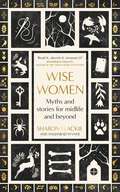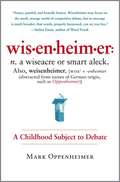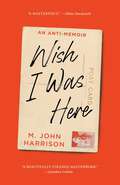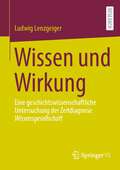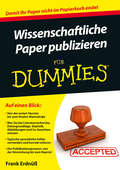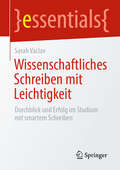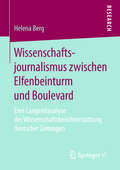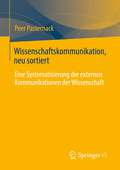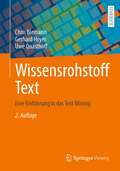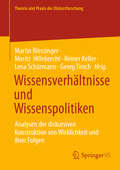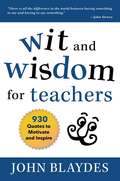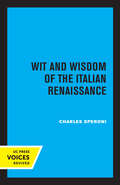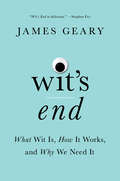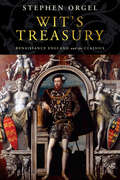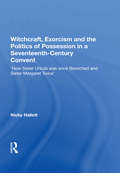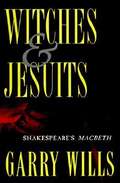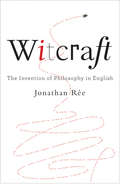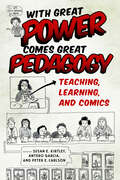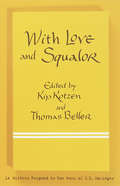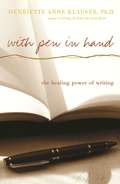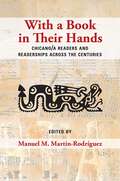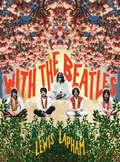- Table View
- List View
Wise Women: Myths and stories for midlife and beyond
by Sharon Blackie Angharad WynneAn unforgettable collection of retold myths and folk tales celebrating the wisdom and power of women in midlife and beyond, from the award-winning author of Hagitude'An extraordinary selection of stories ... beautifully and vividly retold' TLS'Read it, absorb it, treasure it!' SHAHRUKH HUSAIN, author of The Virago Book of Witches'A fascinating collection of female myths and legends' SARA SHERIDAN, author of The Fair BotanistsFrom early childhood, we learn about the world and its possibilities through myths and fairy tales. The heroines, though, tend to be golden-haired princesses, and the evil-doers often older women. But women today are searching for positive versions of themselves from midlife onwards, and this dazzling array of not-to-be-messed-with characters - from ungainly giantesses and sequin-strewn fairy godmothers to misunderstood witches and craggy crones - provides them. They outwit monsters, test and mentor younger heroines, embody the cycles and seasons of the earth, weave the world into being - and almost always have the last laugh.These women manifest their wisdom in different ways, and so offer us inspiration for how we too can walk boldly and live authentically in the second half of life.'Wonderful, both comforting and inspiring' VICTORIA SMITH, author of Hags'The book I've been longing for' JILL DAWSON, author of The Bewitching'I adored Wise Women - this is the missing piece of the jigsaw puzzle when it comes to reframing the narrative in our culture about the role of older females' ELEANOR MILLS, author of Much More to Come: Lessons on the mayhem and magnificence of midlife 'Reading it quenched a thirst I didn't know I had. Oh for a world where stories of the power and joy of women's elder years are celebrated everywhere' DOREEN CUNNINGHAM, author of Soundings'Revisits our old stories, making them thrilling for us now' STELLA DUFFY OBE
Wise Women: Myths and stories for midlife and beyond - 'Extraordinary ... beautifully and vividly retold stories' TLS
by Sharon Blackie Angharad WynneAn unforgettable collection of retold myths and folk tales celebrating the wisdom and power of women in midlife and beyond, from the award-winning author of Hagitude'An extraordinary selection of stories ... beautifully and vividly retold' TLS'Read it, absorb it, treasure it!' SHAHRUKH HUSAIN, author of The Virago Book of Witches'A fascinating collection of female myths and legends' SARA SHERIDAN, author of The Fair BotanistsFrom early childhood, we learn about the world and its possibilities through myths and fairy tales. The heroines, though, tend to be golden-haired princesses, and the evil-doers often older women. But women today are searching for positive versions of themselves from midlife onwards, and this dazzling array of not-to-be-messed-with characters - from ungainly giantesses and sequin-strewn fairy godmothers to misunderstood witches and craggy crones - provides them. They outwit monsters, test and mentor younger heroines, embody the cycles and seasons of the earth, weave the world into being - and almost always have the last laugh.These women manifest their wisdom in different ways, and so offer us inspiration for how we too can walk boldly and live authentically in the second half of life.'Wonderful, both comforting and inspiring' VICTORIA SMITH, author of Hags'The book I've been longing for' JILL DAWSON, author of The Bewitching'I adored Wise Women - this is the missing piece of the jigsaw puzzle when it comes to reframing the narrative in our culture about the role of older females' ELEANOR MILLS, author of Much More to Come: Lessons on the mayhem and magnificence of midlife 'Reading it quenched a thirst I didn't know I had. Oh for a world where stories of the power and joy of women's elder years are celebrated everywhere' DOREEN CUNNINGHAM, author of Soundings'Revisits our old stories, making them thrilling for us now' STELLA DUFFY OBE
Wisenheimer: A Childhood Subject to Debate
by Mark OppenheimerHave you ever met a child who talked like an adult? Who knew big words and how to use them? Was he a charmer or an insufferable smart aleck--or maybe both? Mark Oppenheimer was just such a boy, his talent for language a curse as much as a blessing. But when he got to junior high, Oppenheimer discovered an outlet for his loquaciousness: the debate team. Frank and comical, Wisenheimer chronicles the travails of a hyperarticulate child who finds salvation in the heady world of competitive oratory. In stirring prose, Oppenheimer describes what it was like to have a gift with no useful application. Unlike math or music prodigies, he had no way to showcase his unique skill, except to speak like a miniature adult--a trick some found impressive but others found irritating. Frustrated and isolated, Oppenheimer used his powers for ill--he became a wisenheimer, pushing his peers and teachers away. Then, in junior high, he discovered the world he was meant for: the debate club. His skill with language was finally being channeled, refined, and honed into something beautiful. As Oppenheimer blossomed as a person, he also became a world-champion high school and college debater. His journey from loneliness to fulfillment affords a fascinating inside look at the extraordinary subculture of world-class high school debate and at the power of language to change one's life. Oppenheimer writes movingly about the art of rhetoric, of his passion for it, and of the inspiration he derived from debating and watching others do it. This smart, funny memoir not only reveals a strange, compelling subculture, it also offers a broader discussion of the splendor and power of language and of the social and developmental hazards of being a gifted child. Finally, it looks with hope at our present age, in which oratory is once again an important force in American culture. Revealing, touching, and entertaining, Wisenheimer offers a brilliant portrait of the rarefied world of high school and college debate--and of what it's like to grow up talkative in America.
Wish I Was Here
by M. John HarrisonBOOK OF THE YEAR IN THE GUARDIAN, THE OBSERVER (LONDON), GRANTA, AND TLS One of our greatest and most original living writers sets out the perils of the writing life with joyful provocation in this &“anti-memoir.&”M. John Harrison has produced one of the greatest bodies of fiction of any living British author, encompassing space opera, speculative fiction, fantasy, and magical and literary realism. But is there even an M. John Harrison and if so, where do we find him? This is the question the author asks in this memoir-as-mystery, turning for clues to forty years of notetaking: &“A note or it never happened. A note or you never looked.&” Are these notebooks records of failed presence? How do they shine a light on a childhood in the industrial Midlands, a portrait of a young artist in counterculture London, on an adulthood of restless escape into hill and moorland landscapes? And do they tell us anything about the writing of books, each one so different from the last that it might have been written by another version of the author? With aphoristic daring and laconic wit, this anti-memoir will fascinate and delight. It confirms M. John Harrison still further in his status as the most original British writer of his generation. &“Wish I Was Here is a beautifully strange masterwork. It is as if M. John Harrison&’s prose devises its own autobiography, while the figure of its author stands to one side tinkering at a eulogy for a dead cat, a manifesto against ruin porn, and a manual of operating procedures for creativity as funky as a Brian Eno card deck. How can this also produce a sublime fugue on memory and aging? Read it and see.&” —Jonathan Lethem, author of Motherless Brooklyn and The Fortress of Solitude
Wissen und Wirkung: Eine geschichtswissenschaftliche Untersuchung der Zeitdiagnose Wissensgesellschaft
by Ludwig LenzgeigerDie Diagnose der „Wissens- und Informationsgesellschaft“ prägt seit den 1960er Jahren die wissenschaftliche Diskussion um die Beschreibung der Gesellschaft in einem internationalen Debattenkontext. Bis heute spielen die „Wissens-“, die „Informations-“ respektive die „Wissens- und Informationsgesellschaft“ eine gewichtige Rolle in der politischen wie wissenschaftlichen Kommunikation. Indem die Biographie einer Idee in den Systemen "Wissenschaft" und "Politik" geschrieben wird, liefert die Untersuchung ebenso einen wissensgeschichtlichen Beitrag zum Verständnis davon, wie zeit- und gesellschaftsdiagnostisches Orientierungswissen entsteht, wie dieses innerwissenschaftlich wie außerwissenschaftlich kommuniziert wird und wie selbiges dadurch verwandelt und interpretiert wird. Schließlich wird durch die Untersuchung der politischen Adaption einer Zeitdiagnose aufgeschlüsselt, wie Deutungswissen genutzt wird und so politische Realitäten entstehen, die Handeln koordinieren.
Wissenschaftliche Paper publizieren für Dummies
by Frank ErdnüßEs ist soweit: Sie haben endlose Zeit im Labor, Feld oder über Literaturbergen verbracht und nun ist es an der Zeit, Ihre Erkenntnisse der wissenschaftlichen Gemeinschaft mitzuteilen; kurzum Sie müssen oder wollen in einer Fachzeitschrift publizieren. Dabei gibt es einiges zu beachten und meist ist die Zeit auch noch knapp. Aber keine Sorge, Frank Erdnüß hat für Sie kurz alles Wichtige zusammengestellt, was es bei einer wissenschaftlichen Veröffentlichung zu beachten gibt. Egal ob es Ihr erstes Paper ist oder ob Sie schon Publikationserfahrung haben; Sie erhalten Tipps zur Auswahl des richtigen Journals, zu Statistik, Literaturverwaltung, Grafiken, Zitierweisen, Wissenschaftsenglisch und vielem mehr. Dieses praxisnahe Buch begleitet Sie über die gesamte Manuskripterstellung und den Publikationsprozess hinweg, bis es schließlich heißt: Paper accepted.
Wissenschaftliches Schreiben mit Leichtigkeit: Durchblick und Erfolg im Studium mit smartem Schreiben (essentials)
by Sarah VaclavIn diesem praxisnahen Essential entmystifiziert ein erfahrener Schreibcoach das wissenschaftliche Schreiben und macht es zugänglich für Studierende aller Fachbereiche, sodass es der Freude am Studium nicht mehr im Weg steht. Mit einem innovativen Ansatz, der Strategie, Kreativität und Individualität vereint, wird das Schreiben von wissenschaftlichen Arbeiten zu einer bereichernden und weniger belastenden Erfahrung. Der Leitfaden motiviert und unterstützt Studierende aktiv bei der Erstellung von Essays, Hausarbeiten, Referaten und mehr, indem er praktische Tipps und bewährte Techniken bietet. Mit diesem Buch an der Seite erhalten Studierende nicht nur wertvolles Handwerkszeug, sondern auch die nötige Zuversicht, um ihre akademischen Texte erfolgreich und selbstbewusst zu gestalten. Ein unverzichtbarer Begleiter für alle, die ihre Schreibfähigkeiten verbessern und ihre wissenschaftlichen Arbeiten erfolgreich meistern möchten.
Wissenschaftsjournalismus zwischen Elfenbeinturm und Boulevard: Eine Langzeitanalyse Der Wissenschaftsberichterstattung Deutscher Zeitungen
by Helena BergHelena Berg beschäftigt sich mit der Frage nach Boulevardisierungstendenzen in der Wissenschaftsberichterstattung deutscher überregionaler Qualitätszeitungen. Basierend auf einer Inhaltsanalyse im Zeitraum von 1995 bis einschließlich 2014 untersucht die Autorin Veränderungen der Berichterstattung im Hinblick auf zentrale gestalterische, inhaltliche und sprachliche Merkmale des Boulevardjournalismus. Dabei stellt sie Gemeinsamkeiten und Unterschiede in der Entwicklung der fünf analysierten Zeitungen heraus und nimmt eine differenzierte Betrachtung des Zusammenhangs von Boulevardisierungsprozessen und journalistischer Qualität vor.
Wissenschaftskommunikation, neu sortiert: Eine Systematisierung der externen Kommunikationen der Wissenschaft
by Peer PasternackDer Ausgangspunkt dieser Neusortierung ist: Wissenschaftskommunikation ist die Kontaktaufnahme und -pflege der Wissenschaft mit der Nichtwissenschaft, also mit ihrer Umwelt. Damit wird das Verständnis von Wissenschaftskommunikation sowohl eingeschränkt als auch erweitert: eingeschränkt auf die externe Kommunikation der Wissenschaft, erweitert auf jegliche Kontaktaufnahmen und -pflege der Wissenschaft mit der Nichtwissenschaft.Es zeigt sich, dass es sehr viel mehr Wissenschaftskommunikation gibt, als man gemeinhin denkt, darunter zahlreiche Varianten, die noch gar nicht als Wissenschaftskommunikation erkannt werden. Zugleich zeigt sich: Gemessen an der Verarbeitbarkeit der Angebote findet zu viel Wissenschaftskommunikation statt, und gemessen an der Wirksamkeit der Angebote findet zu wenig effektive, d. h. zielerreichende Wissenschaftskommunikation statt. Um das zu ändern, bedarf es eines deutlichen Bildes davon, was Wissenschaftskommunikation ist, wie sie von anderen Kommunikationen abgegrenzt ist und wie sie intern differenziert ist. Dieses Bild wird hier gezeichnet.
Wissensrohstoff Text: Eine Einführung in das Text Mining
by Chris Biemann Gerhard Heyer Uwe QuasthoffDer größte Teil des Weltwissens ist in digital verfügbaren Texten beschrieben. Diese Texte stellen einen bedeutsamen Wissensrohstoff dar, doch wie kann dieses Wissen extrahiert werden? Lernen Sie in dieser aktualisierten und erweiterten Neuauflage des ersten deutschen Lehrbuches zu diesem Thema, wie digitaler Text mit Hilfe von Text Mining aufbereitet, verarbeitet und in Anwendungen genutzt werden kann.
Wissensverhältnisse und Wissenspolitiken: Analysen der diskursiven Konstruktion von Wirklichkeit und ihrer Folgen (Theorie und Praxis der Diskursforschung)
by Reiner Keller Lena Schürmann Martin Blessinger Moritz Hillebrecht Georg TirochDie Wissenssoziologische Diskursanalyse (WDA) analysiert gesellschaftliche Wissensverhältnisse und Wissenspolitiken. Sie entwirft dazu theoretische und methodologische Grundlagen sowie Vorschläge zur methodischen Umsetzung. Das beinhaltet kein standardisiertes Rezeptwissen, sondern Angebote, die dann für konkrete Studien angepasst werden müssen. Die Beiträge des Bandes greifen Fragen wissenssoziologischer Diskursforschung auf und beziehen sich in unterschiedlicher Weise auf die WDA und angrenzende Ansätze der Wissensanalyse. Sie nutzen, modifizieren und erweitern diese Perspektiven, um die diskursive Konstruktion von Wirklichkeit zu untersuchen. Schwerpunkte liegen auf Wissensverhältnissen, Subjektpositionen und Subjektivierungen sowie methodischen und methodologischen Erweiterungen.
Wit and Wisdom for Teachers: 930 Quotes to Motivate and Inspire
by John BlaydesNationally acclaimed speaker and educator John Blaydes complies nuggets of wit and wisdom to motivate and inspire his fellow educators. The Educator&’s Book of Quotes is a comprehensive resource for quotes relating to education and leadership, organized by sixteen themes for easy access and reference, including: The Art of TeachingBalancing the Time CrunchPrinciples and PrincipalsCreating a Culture of ExcellenceInspirational LeadershipEducation is KeyContaining hundreds of inspirational quotes for teachers in all stages of their career, The Educator&’s Book of Quotes is a must have.
Wit and Wisdom of the Italian Renaissance
by Charles SperoniThis is the first ample collection of facetiae, or witty tales, from the Italian Renaissance to be published in English. Witty and wise anecdotes had been known to the ancient Greeks and Romans in the form of apothegms, but not until the Renaissance did the true facetia acquire an independent life and popularity, and begin to spread rapidly throughout Italy and beyond the Alps. The publication of Poggio Bracciolini's Liberfacetiarum was largely responsible for this vogue: his collection met with tremendous success and resulted in the assembly of numerous other collection of facetiae. The facetia, which has some affinities with the longer, more carefully elaborated novella, is a brief narrative, varying in length from a few lines to two or three pages, whose main purpose it to entertain an excite laughter, and often concludes with a piece of pungent repartee. Both the facetia and the novella have often been censured for licentiousness, but most of them have a healthy moral, or at least a shrewd bit of psychology to impart. Above all, the facetia, like the novella, adds a new dimension to the overall, complex picture of the Renaissance. This title is part of UC Press's Voices Revived program, which commemorates University of California Press's mission to seek out and cultivate the brightest minds and give them voice, reach, and impact. Drawing on a backlist dating to 1893, Voices Revived makes high-quality, peer-reviewed scholarship accessible once again using print-on-demand technology. This title was originally published in 1964.
Wit's End: What Wit Is, How It Works, And Why We Need It
by James Geary"A witty book about wit that steers an elegant path between waggishness and wisdom." —Stephen Fry Much more than a knack for snappy comebacks, wit is the quick, instinctive intelligence that allows us to think, say, or do the right thing at the right time in the right place. In this whimsical book, James Geary explores every facet of wittiness, from its role in innovation to why puns are the highest form of wit. Geary reasons that wit is both visual and verbal, physical and intellectual: there’s the serendipitous wit of scientists, the crafty wit of inventors, the optical wit of artists, and the metaphysical wit of philosophers. In Wit’s End, Geary embraces wit in every form by adopting a different style for each chapter; he writes the section on verbal repartee as a dramatic dialogue, the neuroscience of wit as a scientific paper, the spirituality of wit as a sermon, and other chapters in jive, rap, and the heroic couplets of Alexander Pope. Wit’s End agilely balances psychology, folktales, visual art, and literary history with lighthearted humor and acute insight, drawing upon traditions of wit from around the world. Entertaining, illuminating, and entirely unique, Wit’s End demonstrates that wit and wisdom are really the same thing.
Wit's Treasury: Renaissance England and the Classics
by Stephen OrgelAs England entered the Renaissance and as humanism, with its focus on classical literature and philosophy, informed the educational system, English intellectuals engaged in a concerted effort to remake the culture, language, manners—indeed, the whole national style—through adapting the classics. But how could English literature, art, and culture, become "classical," not only in imitating the ancients, but in the sense subsequently applied to music: "classical" as opposed to popular, as formal, serious, and therefore as good?For several decades in the sixteenth and early seventeenth centuries, Stephen Orgel writes, the return to the classics held out the promise of refinement and civility. Poetry was to be modeled on Greek and Roman examples rather than on the great English medieval works, which though admirable, lacked "correctness." More than poetry was at stake, however, and the transition would not be easy. Classical rules seemed the wave of the future, rescuing England from what was seen as the crudeness and the sheer popularity of its native traditions, but advocacy was tempered with a good deal of ambivalence: classical manners and morals were often at variance with Christian principles, and the classicism of the age would need to be deeply revisionist. "Christian humanism" was never untroubled, Orgel writes, always an unstable or even paradoxical amalgam.In Wit's Treasury, one of our foremost interpreters of Renaissance literature and culture charts how this ambivalence yielded the rich creative tension out of which emerged an unprecedented flowering of drama, lyric, and the arts. Orgel has here written a book that will appeal to anyone interested in English Renaissance art and literature, and particularly in the cultural ferment that produced Shakespeare, Marlowe, Spenser, Jonson, and Milton.
Witchcraft, Exorcism and the Politics of Possession in a Seventeenth-Century Convent: 'How Sister Ursula was once Bewiched and Sister Margaret Twice' (The\early Modern Englishwoman 1500-1750 Ser.)
by Nicky HallettPresenting a remarkable set of previously unpublished papers, this book concerns the bewitchment, possession and exorcism of two seventeenth-century nuns living in exile in an English convent in the Spanish Netherlands. The two women left behind an extensive set of personal writing that reveals unprecedented detail about their devotional lives and spiritual states before, during and after exorcism. Unlike other similar cases, here the women write for themselves; for the first time in 350 years this book allows their voices - and their silences - to resound in all their vibrancy. An extensive introduction discusses the politics of piety and possession at a time when exorcism had become increasingly contentious, amidst conflicting claims for rival church reform. The book includes both autobiographical and biographical material, written by the nuns and about them, and casting new light on processes of female self-writing at just the time when the 'modern subject' is often said to have emerged.
Witches and Jesuits: Shakespeare's Macbeth
by Garry WillsIn Witches and Jesuits, Wills focuses on a single document to open up a window on an entire society. He begins with a simple question: If Macbeth is such a great tragedy, why do performances of it so often fail? After all, the stage history of Macbeth is so riddled with disasters that it has created a legendary curse on the drama. Superstitious actors try to evade the curse by referring to Macbeth only as "the Scottish play," but production after production continues to soar in its opening scenes, only to sputter towards anticlimax in the later acts. By critical consensus there seems to have been only one entirely successful modern performance of the play, Laurence Olivier's in 1955, and even Olivier twisted his ankle on opening night. But Olivier's ankle notwithstanding, Wills maintains that the fault lies not in Shakespeare's play, but in our selves. Drawing on his intimate knowledge of the vivid intrigue and drama of Jacobean England, Wills restores Macbeth's suspenseful tension by returning it to the context of its own time, recreating the burning theological and political crises of Shakespeare's era. He reveals how deeply Macbeth's original 1606 audiences would have been affected by the notorious Gunpowder Plot of 1605, when a small cell of Jesuits came within a hairbreadth of successfully blowing up not only the King, but the Prince his heir, and all members of the court and Parliament. Wills likens their shock to that endured by Americans following Pearl Harbor or the Kennedy assassination. Furthermore, Wills documents, the Jesuits were widely believed to be acting in the service of the Devil, and so pervasive was the fear of witches that just two years before Macbeth's first performance, King James I added to the witchcraft laws a decree of death for those who procured "the skin, bone, or any other part of any dead person--to be employed or used in any manner of witchcraft, sorcery, charm, or enchantment." We see that the treason and necromancy in Macbeth were more than the imaginings of a gifted playwright--they were dramatizations of very real and potent threats to the realm. In this new light, Macbeth is transformed. Wills presents a drama that is more than a well-scripted story of a murderer getting his just penalty, it is the struggle for the soul of a nation. The death of a King becomes a truly apocalyptic event, and Malcolm, the slain King's son, attains the status of a man defying cosmic evil. The guilt of Lady Macbeth takes on the Faustian aspect of one who has singed her hands in hell. The witches on the heath, shrugged off as mere symbols of Macbeth's inner guilt and ambition by twentieth century interpreters, emerge as independent agents of the occult with their own (or their Master's) terrifying agendas. Restoring the theological politics and supernatural elements that modern directors have shied away from, Wills points the way towards a Macbeth that will finally escape the theatrical curse on "the Scottish play." Rich in insight and a joy to read, Witches and Jesuits is a tour de force of scholarship and imagination by one of our foremost writers, essential reading for anyone who loves the language.
Witcraft: The Invention of Philosophy in English
by Jonathan RéeAn ambitious new history of philosophy in English that broadens the canon to include many lesser-known figures Ludwig Wittgenstein once wrote that “philosophy should be written like poetry.” But philosophy has often been presented more prosaically as a long trudge through canonical authors and great works. But what, Jonathan Rée asks, if we instead saw the history of philosophy as a haphazard series of unmapped forest paths, a mass of individual stories showing endurance, inventiveness, bewilderment, anxiety, impatience, and good humor? Here, Jonathan Rée brilliantly retells this history, covering such figures as Descartes, Locke, Kant, Hegel, Marx, Nietzsche, Mill, James, Frege, Wittgenstein, and Sartre. But he also includes authors not usually associated with philosophy, such as William Hazlitt, George Eliot, Darwin, and W. H. Auden. Above all, he uncovers dozens of unremembered figures—puritans, revolutionaries, pantheists, feminists, nihilists, socialists, and scientists—who were passionate and active readers of philosophy, and often authors themselves. Breaking away from high-altitude narratives, he shows how philosophy finds its way into ordinary lives, enriching and transforming them in unexpected ways.
With Great Power Comes Great Pedagogy: Teaching, Learning, and Comics
by Susan E. Kirtley, Antero Garcia and Peter E. CarlsonContributions by Bart Beaty, Jenny Blenk, Ben Bolling, Peter E. Carlson, Johnathan Flowers, Antero Garcia, Dale Jacobs, Ebony Flowers Kalir, James Kelley, Susan E. Kirtley, Frederik Byrn Køhlert, John A. Lent, Leah Misemer, Johnny Parker II, Nick Sousanis, Aimee Valentine, and Benjamin J. Villarreal More and more educators are using comics in the classroom. As such, this edited volume sets out the stakes, definitions, and exemplars of recent comics pedagogy, from K-12 contexts to higher education instruction to ongoing communities of scholars working outside of the academy. Building upon interdisciplinary approaches to teaching comics and teaching with comics, this book brings together diverse voices to share key theories and research on comics pedagogy. By gathering scholars, creators, and educators across various fields and in K-12 as well as university settings, editors Susan E. Kirtley, Antero Garcia, and Peter E. Carlson significantly expand scholarship. This valuable resource offers both critical pieces and engaging interviews with key comics professionals who reflect on their own teaching experience and on considerations of the benefits of creating comics in education. Included are interviews with acclaimed comics writers Lynda Barry, Brian Michael Bendis, Kelly Sue DeConnick, and David Walker, as well as essays spanning from studying the use of superhero comics in the classroom to the ways comics can enrich and empower young readers. The inclusion of creators, scholars, and teachers leads to perspectives that make this volume unlike any other currently available. These voices echo the diverse needs of the many stakeholders invested in using comics in education today.
With Her Machete in Her Hand: Reading Chicana Lesbians
by Catrióna Rueda EsquibelWith the 1981 publication of the groundbreaking anthology This Bridge Called My Back: Writings by Radical Women of Color, Cherríe Moraga and Gloria Anzaldúa ushered in an era of Chicana lesbian writing. <P><P>But while these two writers have achieved iconic status, observers of the Chicana/o experience have been slow to perceive the existence of a whole community--lesbian and straight, male as well as female--who write about the Chicana lesbian experience. To create a first full map of that community, this book explores a wide range of plays, novels, and short stories by Chicana/o authors that depict lesbian characters or lesbian desire. <P> Catrióna Rueda Esquibel starts from the premise that Chicana/o communities, theories, and feminisms cannot be fully understood without taking account of the perspectives and experiences of Chicana lesbians. To open up these perspectives, she engages in close readings of works centered around the following themes: La Llorona, the Aztec Princess, Sor Juana Inés de la Cruz, girlhood friendships, rural communities and history, and Chicana activism. Her investigation broadens the community of Chicana lesbian writers well beyond Moraga and Anzaldúa, while it also demonstrates that the histories of Chicana lesbians have had to be written in works of fiction because these women have been marginalized and excluded in canonical writings on Chicano life and experience.
With Literacy and Justice for All: Rethinking the Social in Language and Education (Language, Culture, and Teaching Series)
by Carole EdelskyThe third edition of With Literacy and Justice for All: Rethinking the Social in Language and Education continues to document Carole Edelsky's long involvement with socially critical, holistic approaches to the everyday problems and possibilities facing teachers of language and literacy. This book helps education professionals understand the educational/societal situations they are dealing with, and literacy instruction and second language learning in particular contexts. Edelsky does not offer simplistic pedagogical formulas, but rather, progressively works through differences and tensions in the discourses and practices of sociolinguistics, bilingual education, whole language, and critical pedagogy--fields whose practitioners and advocates too often work in isolation from each other and, at times, at cross purposes. In this edition, what Edelsky means by rethinking is improving and extending her own views, while at the same time demonstrating that such rethinking always occurs in the light of history. The volume includes a completely new Introduction and two entirely new chapters: one on reconceptualizing literacy learning as second language learning, and another on taking a historical view of responses to standardized testing. Throughout, in updating the volume, Edelsky uses a variety of structural styles to note contrasts in her views across time and to make the distinction clear between the original material and the current additions. This edition is a rare example of a scholarly owning-up to changes in thinking, and a much needed demonstration of the historically grounded nature of knowledge. As a whole, the third edition emphasizes recursiveness and questioning within a deliberately political framework.
With Love and Squalor: 13 Writers Respond to the Work of J. D. Salinger
by Kip Kotzen Thomas BellerReading The Catcher in the Rye has become a rite of passage for young Americans, landing the book on bestseller lists (and banned book lists) each year, even though it was published a half century ago. What is it about J. D. Salinger and his body of work that has left such a lasting mark on American fiction? And who better to answer that question than the current generation of writers? Here are fourteen of the most vital voices in the contemporary American fiction scene pulling no punches in response to a writer who continues to beguile, charm, fascinate, and frustrate generations of readers. Contributors Walter Kirn, Ren Steinke, Charles D'Ambrosio, Emma Forrest, Aleksander Hemon, Lucinda Rosenfeld, Amy Sohn, John McNally, Karen E. Bender, Thomas Beller, Benjamin Anastas, Aimee Bender, Joel Stein, and Jane Mendelsohn turn themselves inside out as they discuss their personal reactions to reading Salinger classics--not only The Catcher in the Rye but also Franny and Zooey, Raise High the Roofbeams, Carpenters, and the short stories--and explore, with begrudging gratitude, how Salinger helped to form the deepest reaches of their literary imaginations.
With Pen in Hand: The Healing Power of Writing
by Henriette Anne KlauserIn moments of grief or loss, we often turn to the written word to say what cannot be said aloud. Indeed, directing sadness, rage, or confusion at the page can be tremendously cathartic and liberating. As we express our deepest feelings without reserve in poetry or prose, we feel the power of our words begin to draw out some of the pain in our hearts and replace it with hope. But fears about writing honestly and self-criticism can stand in the way of making use of this powerful therapeutic tool. With Pen in Hand is an inspirational and practical guide to breaking through these roadblocks and to helping one "write to heal. " Outlining writing techniques that are best for working through pain and for privately collecting raw emotions--"Writing a Letter of Goodbye," "Interviewing Your Body," "Rapid-Writing," and more--Henriette Klauser shares stories and tips that will help readers gain comfort from what they commit to paper. For the accomplished writer and non-writer alike, With Pen in Hand will help one make use of the kind of expression that in the aftermath of a crisis or loss, can make one whole again.
With a Book in Their Hands: Chicano/a Readers and Readerships across the Centuries
by Manuel M. Martín-RodríguezFirst Place Winner of the 2015 International Latino Book Award for Best Latino Focused Nonfiction Book Literary history is a history of reading. What happens during the act of reading is the subject of the branch of literary scholarship known as reader-response theory. Does the text guide the reader? Does the reader operate independently of the text? Questions like these shape the approach of the essays in this book, edited by a scholar known for his groundbreaking work in using reader-response theory as a window into Chicana and Chicano literature. Manuel M. Martín-Rodríguez has overseen several research projects aimed at documenting Chicana and Chicano reading practices and experiences. Here he gathers diverse and passionate accounts of reading drawn from that research. For many, books served as refuges from the sorrows of a childhood marked by violence or parental abandonment. Several of the contributors here salute the roles of teachers in introducing poetry and stories into their lives.
With the Beatles
by Lewis LaphamHalfway between the summer of love and the Tet offensive, the Beatles went to India to study with the Maharishi--and Lewis Lapham, esteemed Harper's editor and award-winning writer, was there. WITH THE BEATLES is a remarkable book of cultural commentary on that seminal '60s moment.The ashram in Rishikesh, India was the ultimate '60s scene: the Beatles, Donovan, Mia Farrow, a stray Beach Boy and other '60s icons gathered along the shores of the Ganges--amidst paisley and incense and flowers and guitars--to meditate at the feet of the Maharishi Mahesh Yogi. The February 1968 gathering received such frenzied, world-wide attention that it is still considered a significant, early encounter between Western pop culture and the mystical East. And Lewis Lapham was the only journalist allowed inside.And what went on inside the compound has long been the subject of wild speculation and rampant rumor. The Beatles said they wrote some of their greatest songs there . . . and yet they also came away bitterly disillusioned. In WITH THE BEATLES, Lewis Lapham finally tells the whole story.
